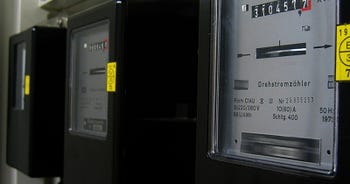How do standing charges work on business energy contracts?
Most business energy contracts come with a standing charge. This is a flat fee that's charged daily, regardless of whether or not you use any gas or electricity.
Although there are tariffs that have no standing charge, these are rare and generally only available on business gas tariffs in the UK. And while you may think a no standing charge energy contract has to be a better option, it could work out more expensive.
Let's take a more detailed look at standing charges and what they're used for, along with the pros and cons of a no standing charge energy deal.

What is a standing charge?
A standing charge is an amount you have to pay for the energy company to supply you with gas and electricity. It covers the costs associated with keeping your property connected to the energy network. This includes service administration fees, network maintenance, and the cost of meter reading visits.
The cost of building pylons and fitting cables is also covered by the standing charge. It's also used to recover unpaid energy bills and supplier of last resort payments. This is when an energy supplier goes bust and its customers are moved to another provider.
In 2016, Ofgem declared that it’s no longer required to have a standing charge applied to an energy tariff. But there are still very few ‘no standing charge’ tariffs available.
Why are standing charges increasing?
The energy price cap is one reason why standing charges have increased. This limits the amount suppliers can charge domestic customers on their default energy tariffs. This includes the unit rate and standing charge. But there are no rules on how suppliers spilt the capped amount between the unit rate and standing charge. This has seen some suppliers push up the standing charge.
But there's no price cap on business energy, so why are non-domestic energy users seeing hikes in their standing charges? One reason could be that suppliers have had to cover the cost of dozens of suppliers going bust over the last few years. Another could be to cover increased transportation costs caused by supply chain issues - if it becomes more expensive to get the energy to customers' premises, these costs will be passed on by suppliers.
How do standing charges work on different energy contracts?
Standing charges can be applied differently depending on what type of contract you’re on. If your agreement includes a standing charge, then it will be applied regardless of your energy use — even if you use no energy at all.
When you compare business energy, consider your unique circumstances. Are you only open at certain times throughout the day? Do you use a lot of energy? The answers to these questions can impact your costs significantly.
Fixed contracts
A fixed contract offers you the opportunity to lock in your gas and electricity prices for a while, removing the fear of spiralling costs. While you may be paying slightly more per unit of energy you use on a fixed contract, it does mean you know what you’ll be paying each month.
Your supplier can’t raise your standing charge in line with wholesale energy market price fluctuations on a fixed contract. Equally, though, you’ll miss out on lower charges if the market drops.
While you can’t currently secure an electricity tariff without a standing charge, it’s worth looking at the costs when it comes to comparing your fixed-term gas contract. A ‘no standing charge’ contract is likely to have a higher rate overall, so it’s prudent to calculate what the difference might be. It may not always save you money to go with no standing charge.
Additionally, you may have to pay if you want to leave to switch to another supplier if you’re on a fixed contract. Your supplier will write a termination fee into your agreement, so always check you’re happy with it before you sign on the dotted line.
Variable contracts
Choosing a variable or flexible contract might be a better solution if your energy consumption is quite high. It can also mean you aren’t tied in for as long — usually only 30 days — making it easier to switch suppliers or move over to a better tariff.
Your standing charge on a variable contract might be less easy to spot on your bill, hiding in plain sight under a pass-through clause. This allows your supplier to increase the unit charge and standing charge if they see their costs increase, allowing them to maintain their margins.
Are standing charges different for business energy users than for domestic customers?
Business customers might pay different standing charges than those a domestic customer might pay.
This is because the charge is linked to maintaining the supply to your premises, including infrastructure, so it may vary depending on your use. Your business may even be subject to additional charges imposed by the government relating to reducing carbon emissions.
How much is the standing charge for business energy?
The cost of your standing charge will depend upon the type of energy deal your business is on, the size of your business, the amount of energy it uses, and its TCR band. TCR stands for targeted charging review, which is an Ofgem initiative that shifted energy distribution and transmission charges (known as DUoS and TNUoS charges) from energy unit rates to standing charges.
But to give you an idea of how much you can expect to pay, below is a breakdown of the average standing charges for business gas and business electricity on contracts sold by Bionic between July 10 and July 17, 2023.
How much is the standing charge for business electricity?
| Business size | Standing charge (daily) |
| Microbusiness | 46.2p |
| Small business | 68.1p |
| Medium business | 147.4p |
| Large business | 96.9p |
How much is the standing charge for business gas?
| Business size | Standing charge (daily) |
| Microbusiness | 29.4p |
| Small business | 44.3p |
| Medium business | 94.8p |
| Large business | 49.0p |
Note: Rates and bill size may vary according to your meter type and business location. Current market volatility may also mean that the prices you’re quoted are different from the averages shown. The figures shown are the average unit rates and standing charges quoted by Bionic per business size from July 10 to July 17, 2023. Rates do not include any Energy Bills Discount Scheme discount.
What is Targeted Charging Review (TCR)?
TCR was introduced by Ofgem to modernise the electricity network and level out transmission (TNUoS) and distribution (DUoS) charges across a wider mix of customers. Before we explain what that means, here’s a quick refresher on the transmission and distribution you’ll find on your business energy bills:
- TNUoS (Transmission Network Use of System) charges cover the cost of building and maintaining transmission infrastructure (like pylons)
- DUoS (Distribution Use of System) charges cover the cost of installing and maintaining local electricity distribution networks that help distribute power to your business (like substations)
These charges used to be included as part of the unit rate, but changes in energy generation and consumption have seen a growing number of businesses become less reliant on the grid. This meant that fewer businesses were contributing to these transmission and distribution network charges and those that were had to pay more to make up the shortfall.
That’s why Ofgem changed how they were funded. The regulator decided that best way to level the playing field, so more businesses contributed, was to apply these fees to the standing charge.
As part of the shake-up, each business was allocated a TCR Band by their local distribution network (for example, UK Power Networks would have allocated TCR Bands to businesses across London, the South East and East of England).
- The DUoS element of the change took effect on April 1, 2022
- The TNUoS element took effect on April 1, 2023
These bands are allocated on meter size, not consumption. If, for instance, you use a relatively low amount of energy but have a half-hourly meter (which is used for high-consumption businesses), they will be allocated a higher TCR band.
The effect of all of this might be that a business that is used to paying an average standing charge (say £1 to £2 per day) could now pay something closer to £10 per day.
If you're in this position and think your standing charge is too high, it could be worth speaking to your business energy supplier to find out if you can get a replacement meter or change the profile of your existing meter. You can find out more in our guide to business energy meter installation.
Are energy deals with no standing charge available?
It is possible to switch to a ‘no standing charge’ energy tariff for your gas supply. This means you’ll only be paying for the gas you’re using. Valda Energy is currently offering no-standing charge business energy contracts. Check out the latest business energy rates and standing charges now.
That said, your unit rates may be higher as a result. Whether you save money depends on when, how, and where you use your energy as to whether you’ll save.
We have a team of experts who can help to guide you through this process. Why not get in touch to discover if you could save on your business gas prices with Bionic?
‘No standing charge’ tariffs: The pros and cons
To help you to decide what is best for your business, we’ve listed out some pros and cons of ‘no standing charges’ tariffs.
Pros
- You’ll only pay on the days your business premises are being used.
- If your energy usage is relatively low, a ‘no standing charge’ tariff may offer you savings overall.
Cons
- You may be subject to higher unit rates on a ‘no standing charge’ tariff; essentially, everything you use will cost you more. You may get a better rate if you regularly pass a certain usage threshold, though.
- If you use a lot of energy in your business, you’re likely to pay a lot more due to the higher unit rates on a ‘no standing charge’ tariff.
Since standing charges stopped being a requirement back in 2016, more and more suppliers are offering a range of ‘no standing charge’ gas tariffs to their customers.
If you’re unsure whether your business would benefit from a ‘no standing charge’ tariff, get in touch with our team of energy experts to find out more.
How Bionic can help you get the best energy deal
When comparing business energy deals, you'll notice there are no off-the-shelf options like with domestic energy deals. That's because commercial energy deals are tailored to the needs of each individual business.
The tech-enabled experts at Bionic can take the time and hassle out of comparing and switching business energy suppliers. We use smart data to cut down the amount of form-filling you need to do, and compare deals from our panel of energy suppliers.
We'll then talk you through the quotes on screen and answer any questions, so you can be confident you're getting the best contract for your business. And our Digital Renewal Service means we proactively look for another great deal when your current one is coming to an end.
To start comparing business energy quotes, just pop your postcode in the box on the right or call 0800 156 0899.








